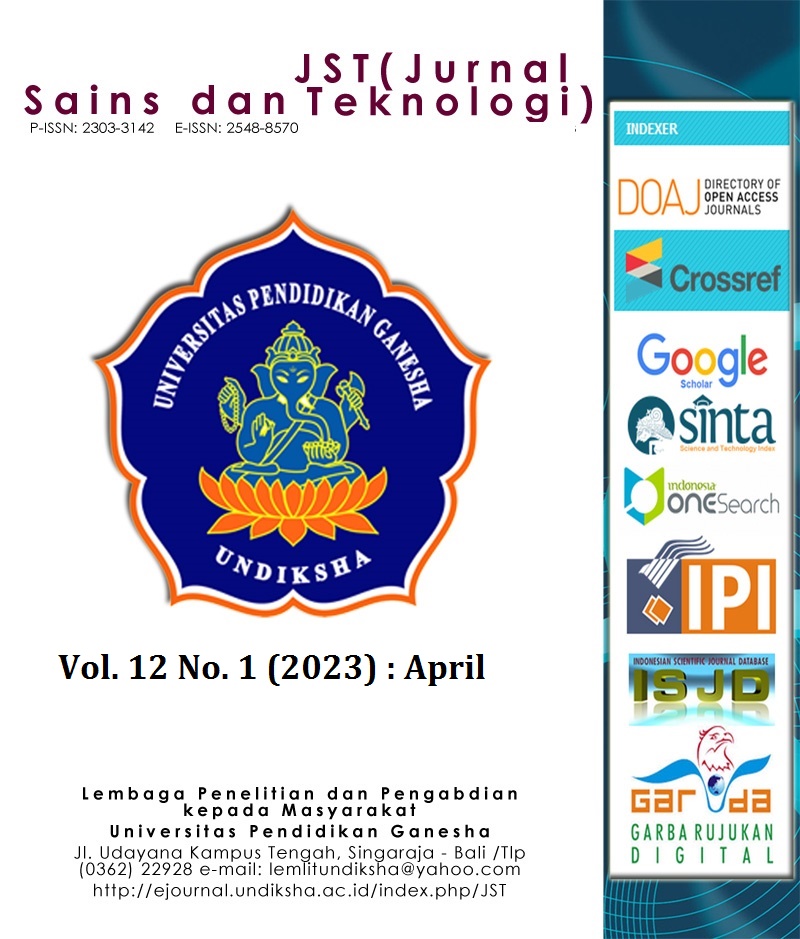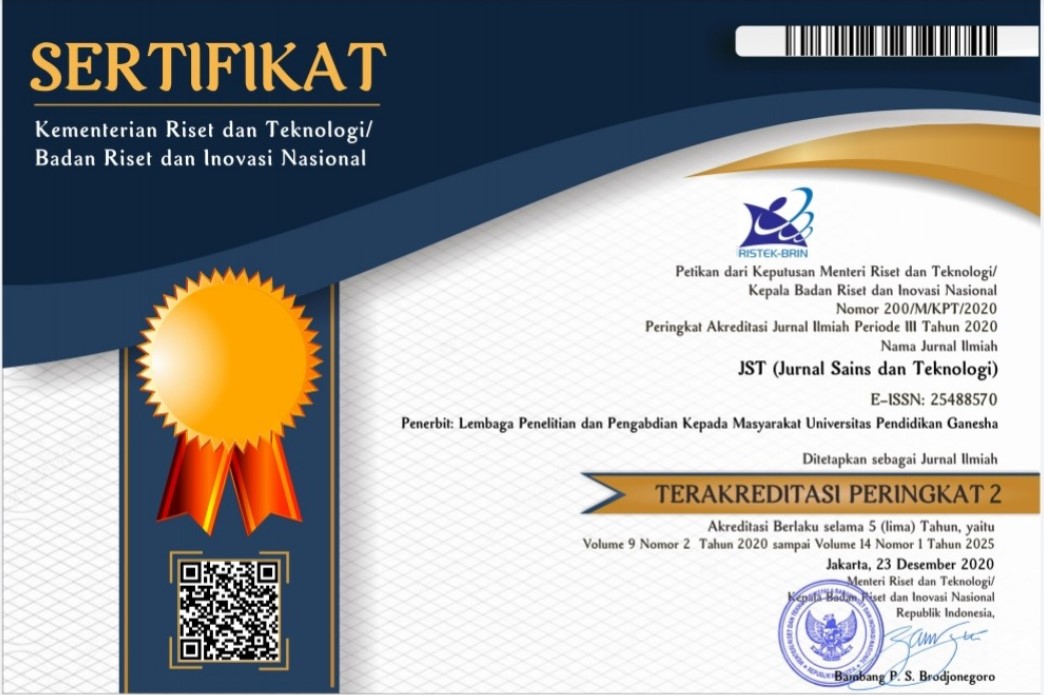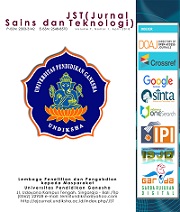The Effect of Chi Square Feature Selection on the Naïve Bayes Algorithm on the Analysis of Indonesian Society's Sentiment About Face-to-Face Learning During the Covid-19 Pandemic
DOI:
https://doi.org/10.23887/jstundiksha.v12i1.51899Kata Kunci:
Sentiment Analysis, Chi Square, Covid-19, Naïve Bayes, Feature SelectionAbstrak
Criticisms and comments submitted to the Indonesian people regarding government policies regarding face-to-face learning during the Covid-19 pandemic have pros and cons. Not a few parents are worried about this policy because parents are still afraid of the spread of the new cluster of Covid-19 in Indonesia which is growing while on the other hand many people who think this is good to apply considering that online learning is considered less effective because many students are difficult to receive material delivered by teachers online and many students who do not have adequate tools. The number of opinions written on Twitter requires classifying according to the sentiments they must get the tendency of these opinions whether they tend to have neutral opinions, positive or negative. Sentiment analysis in this study was conducted using the Naïve Bayes method and chi square's characteristic selection in conducting classification. The results of the analysis of the Naïve Bayes method with chi square characteristic selection have an accuracy of 93% and without chi square characteristic selection has an accuracy of 92%, so it can be concluded the Naïve Bayes Method with chi square characteristic selection has a better accuracy compared without using chi square characteristic selection.
Referensi
Agustin, M. (2021). Tipikal Kendala Guru PAUD dalam Mengajar pada Masa Pandemi Covid 19 dan Implikasinya. Jurnal Obsesi : Jurnal Pendidikan Anak Usia Dini, 5(1), 334–345. https://doi.org/10.31004/obsesi.v5i1.598.
Amrullah, A. Z., Anas, A. S., & Hidayat, M. A. J. (2020). Analisis Sentimen Movie Review Menggunakan Naive Bayes Classifier Dengan Seleksi Fitur Chi Square. Jurnal Bumigora Information Technology (BITe), 2(1), 40–44. https://doi.org/10.30812/bite.v2i1.804.
Astari, N. M. A. J., Divayana, D. G. H., & Indrawan, G. (2020). Analisis Sentimen Dokumen Twitter Mengenai Dampak Virus Corona Menggunakan Metode Naive Bayes Classifier. Jurnal Sistem Dan Informatika (JSI), 15(1). https://doi.org/10.30864/jsi.v15i1.332.
Berliana, G., Shaufiah, S., & Sa’adah, S. (2018). Klasifikasi Posting Tweet Mengenai Kebijakan Pemerintah Menggunakan Naïve Bayesian Classification. EProceedings of Engineering, 5(1).
Buslim, N., Putra, A. E., & Luh Kesuma Wardhani. (2019). Chi-Square Feature Selection Effect On Naive Bayes Classifier Algorithm Performance For Sentiment Analysis Document. Conference: 2019 7th International Conference on Cyber and IT Service Management (CITSM). https://doi.org/10.1109/CITSM47753.2019.8965332.
Ernawati dkk, S. Y. (2018). Implementation of The Naïve Bayes Algorithm with Feature Selection using Genetic Algorithm for Sentiment Review Analysis of Fashion Online Companies. International Conference on Cyber and IT Service Management (CITSM), 1–5. https://doi.org/10.1109/CITSM.2018.8674286.
Fairuz, A. L., Ramadhani, R. D., & Tanjung, N. A. F. (2021). Analisis Sentimen Masyarakat Terhadap COVID-19 Pada Media Sosial Twitter. Journal of Dinda (Data Science, Information Tehcnology, and Data Analytics), 1(1). https://doi.org/10.20895/dinda.v1i1.180.
Fauziyyah, A. K. (2020). Analisis Sentimen Pandemi Covid19 Pada Streaming Twitter Dengan Text Mining Python. Jurnal Ilmiah SINUS, 18(2). https://doi.org/10.30646/sinus.v18i2.491.
Haryanto, A. W., Mawardi, E. K., & Muljono. (2018). Influence of Word Normalization and Chi-Squared Feature Selection on Support Vector Machine (SVM) Text Classification. International Seminar on Application for Technology of Information and Communication. https://doi.org/10.1109/ISEMANTIC.2018.8549748.
Kurniawan, Y. I. (2018). Perbandingan Algoritma Naive Bayes Dan C.45 Dalam Klasifikasi Data Mining. Jurnal Teknologi Informasi Dan Ilmu Komputer, 5(4). https://doi.org/10.25126/jtiik.201854803.
Muhammad, A. N., Bukhori, S., & Pandunata, P. (2019). Sentiment analysis of positive and negative of youtube comments using naïve bayes–support vector machine (nbsvm) classifier. International Conference on Computer Science, Information Technology, and Electrical Engineering (ICOMITEE), 199–205. https://doi.org/10.1109/ICOMITEE.2019.8920923.
Nahdi, K., Ramdhani, S., Yuliatin, R. R., & Hadi, Y. A. (2020). Implementasi Pembelajaran pada Masa Lockdown bagi Lembaga PAUD di Kabupaten Lombok Timur. Jurnal Obsesi : Jurnal Pendidikan Anak Usia Dini, 5(1), 177–186. https://doi.org/10.31004/obsesi.v5i1.529.
Nissa, S. F., & Haryanto, A. (2020). Implementasi Pembelajaran Tatap Muka Di Masa Pandemi Covid-19. Jurnal IKA PGSD (Ikatan Alumni PGSD) UNARS, 8(2), 402. https://doi.org/10.36841/pgsdunars.v8i2.840.
Pakpahan, R., & Fitriani, Y. (2020). Analisa Pemafaatan Teknologi Informasi Dalam Pemeblajaran Jarak Jauh Di Tengah Pandemi Virus Corona Covid-19. JISAMAR (Journal of Information System, Applied, Management, Accounting and Researh), 4(2), 30–36.
Rizal, M., Afrianti, R., & Abdurahman, I. (2021). Dampak Kebijakan Pemberlakuan Pembatasan Kegiatan Masyarakat ( PPKM ) bagi Pelaku Bisnis Coffe shop pada Masa Pandemi Terdampak COVID-19 di Kabupaten Purwakarta The Impact of the Policy for Implementing Community Activity Restrictions for Coffee Shop Busi. Jurnal Inspirasi, 12(1), 97–105.
Rodiyansyah, S. F., & Winarko, E. (2012). Klasifikasi Posting Twitter Kemacetan Lalu Lintas Kota Bandung Menggunakan Naive Bayesian Classification. IJCCS - Indonesian Journal of Computing and Cybernetics Systems, 6(1). https://doi.org/10.22146/ijccs.2144.
Sari, I. C., & Yova, R. (2020). Sentiment Analysis of the Covid-19 Virus Infection in Indonesian Public Transportation on Twitter Data: A Case Study of Commuter Line Passengers. International Workshop on Big Data and Information Security (IWBIS). https://doi.org/10.1109/IWBIS50925.2020.9255531.
Sepita, S. F., & Suryanti, S. (2020). Pengaruh Pembelajaran Daring Terhadap Hasil Belajar Kognitif Mahasiswa Pada Mata Kuliah Limnologi. Journal of Research and Education Chemistry, 2(2), 102. https://doi.org/10.25299/jrec.2020.vol2(2).5826.
Vhalery, R., Nur Alfilail, S., & Robbani, H. (2021). Persepsi Mahasiswa Tentang Pembelajaran Online “Google Classroom” Pada Minat Dan Motivasi Belajar. Intelektium, 2(1). https://doi.org/10.37010/int.v2i1.271.
Widya, S. S., Prasetya, J. I., & Anggrainingsih, R. (2018). Twitter Sentiment Analysis of Movie Reviews Using Information Gain and Naïve Bayes Classifier. International Seminar on Application for Technology of Information and Communication, 190–195. https://doi.org/10.1109/ISEMANTIC.2018.8549757.
Wongkar, M., & Angdresey, A. (2019). Sentiment Analysis Using Naive Bayes Algorithm Of The Data Crawler: Twitter. Fourth International Conference on Informatics and Computing (ICIC), 1–5. https://doi.org/10.1109/ICIC47613.2019.8985884.
Unduhan
Diterbitkan
Cara Mengutip
Terbitan
Bagian
Lisensi
Hak Cipta (c) 2022 A.Habiba, R. Rizal Isnanto, J.Endro Suseno

Artikel ini berlisensiCreative Commons Attribution-ShareAlike 4.0 International License.
Authors who publish with the Jurnal Sains dan Teknologi (JST) agree to the following terms:
- Authors retain copyright and grant the journal the right of first publication with the work simultaneously licensed under a Creative Commons Attribution License (CC BY-SA 4.0) that allows others to share the work with an acknowledgment of the work's authorship and initial publication in this journal.
- Authors are able to enter into separate, additional contractual arrangements for the non-exclusive distribution of the journal's published version of the work (e.g., post it to an institutional repository or publish it in a book), with an acknowledgment of its initial publication in this journal.
- Authors are permitted and encouraged to post their work online (e.g., in institutional repositories or on their website) prior to and during the submission process, as it can lead to productive exchanges, as well as earlier and greater citation of published work. (See The Effect of Open Access)
















